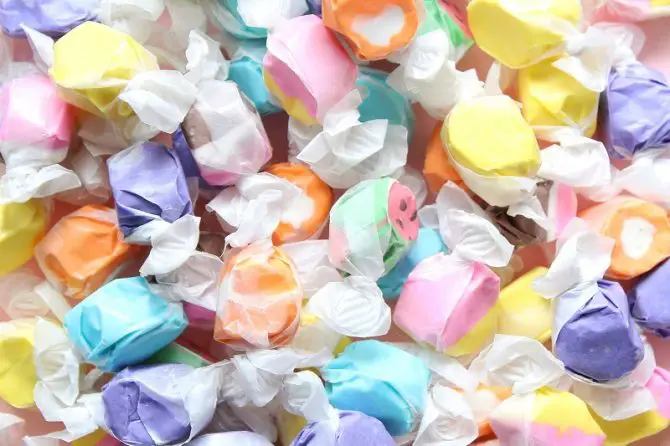What’s in Salt Water Taffy? The True Story Behind the Boardwalk Treat

Taffy is one of those deeply old-fashioned candies that still exist, but is usually only encountered in certain places—chiefly, at the beach. Salt water taffy has been a boardwalk staple for decades, but how did that come to be? And is there actually salt water in it?
Not in the way you might think. There is usually a small amount of salt and some water in all taffy, but so-called salt water taffy doesn’t have a higher amount of either, let alone actual water from the sea; in fact, it’s not distinctly different from regular old taffy in any way save the name.
It’s all made from boiled sugar, corn syrup, and a few other ingredients, including various flavorings and sometimes food coloring. The mixture starts out as an extremely sticky mass that’s also scalding hot, which sounds like a recipe for disaster, but once it’s cooled enough to handle, it’s stretched out and folded back in on itself numerous times to achieve its thick and fluffy, soft yet chewy texture. The constant agitation aerates the mixture, just like whipping cream makes it lofty and light.
Taffy has been enjoyed in America since at least the 1800s; an 1847 recipe from “Mrs. Crowden’s American Lady’s Cookery Book” calls for boiling molasses, flavoring it with lemon, sassafras, or vanilla, and pouring it into buttered tins—but also gives the option of “pulling it in your hands, having first rubbed them over with a bit of butter, to prevent the candy sticking to them,” which would make it lighter in both color and texture. An 1843 cookbook (Mrs. Webster’s “The Improved Housewife”) elaborates on how one would take the mixture “while it is yet warm, and pull it out into a thick string, between the thumb and fore-finger of both hands. Extend your arms widely as you pull the candy backwards and forwards. By repeating this a long time, it will gradually become of a light yellow color, and of a spongy consistency.”

Taffy pulling parties were once a common pastime (you know, before television, gaming consoles, and smartphones were invented), enjoyed by young and old, and even Raggedy Ann and Andy, who starred in an entire (pretty creepy) story about it, in which a houseful of dolls play with fire and make candy while the human occupants are away. In the real world, these shindigs were both a fun activity for small children’s parties and an acceptable way for more mature young adults to get face time with the opposite sex (again, before smartphones).
Candy making wasn’t confined to homes, though, and large wall-mounted hooks made it possible for one person to manually make taffy in fairly large batches, as it had been since the 1800s as well. It did require muscle, and as former President William Howard Taft wrote in 1921, “[t]he work was strenuous, and produced perspiration and uncleanliness. It was done with the bare hands, and…was neither appetizing nor sanitary.”
And yet, it was still immensely popular, especially in Atlantic City, NJ, where the biggest names were Joseph Fralinger and Enoch James. Lots of other producers set up shop there too.
Popular legend says one such candy maker, David Bradley, coined the now-common term “salt water taffy” in 1883, after a storm surge or particularly high tide caused flooding along the boardwalk that inundated his shop with sea water. More likely, some clever but ultimately shortsighted person simply applied the term for marketing purposes, to connote the proximity of the sea and thus imbue the confection with the aura of a special holiday treat—something to enjoy on vacation, but also to bring home with you to tangibly extend the experience and give as a souvenir to others too. “Salt water taffy” does sound vaguely magical and ethereal, like fairy bread.
The evocative name was never trademarked, though. John R. Edmiston tried to stake a claim in 1925, about 40 years too late. By then, hundreds of confectioners (along the Atlantic coast and elsewhere in the U.S.) had been selling salt water taffy for decades, and the court ruled that the term couldn’t be officially registered.
The actual process of making it, of course, has come a long way since then—the first taffy pulling machine was patented in 1893, and such contraptions continue to evolve. The flavors have grown in scope too (piña colada, bubblegum, and cookie dough can now easily be had along with classic versions like vanilla and molasses). But the original chewy candy continues to beckon beach-goers from coast to coast, and its name to inspire wonder over whether a little bit of the ocean actually makes it inside the sweet.
Related Video: How to Make Maple Syrup Snow Candy
[page_popup id=”1″]




